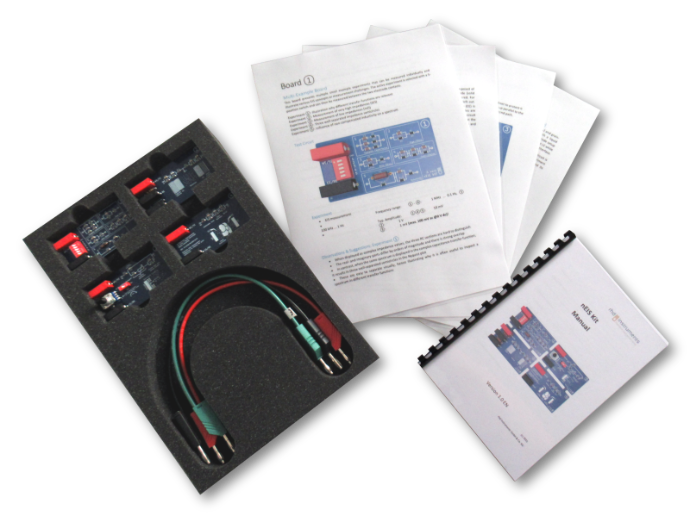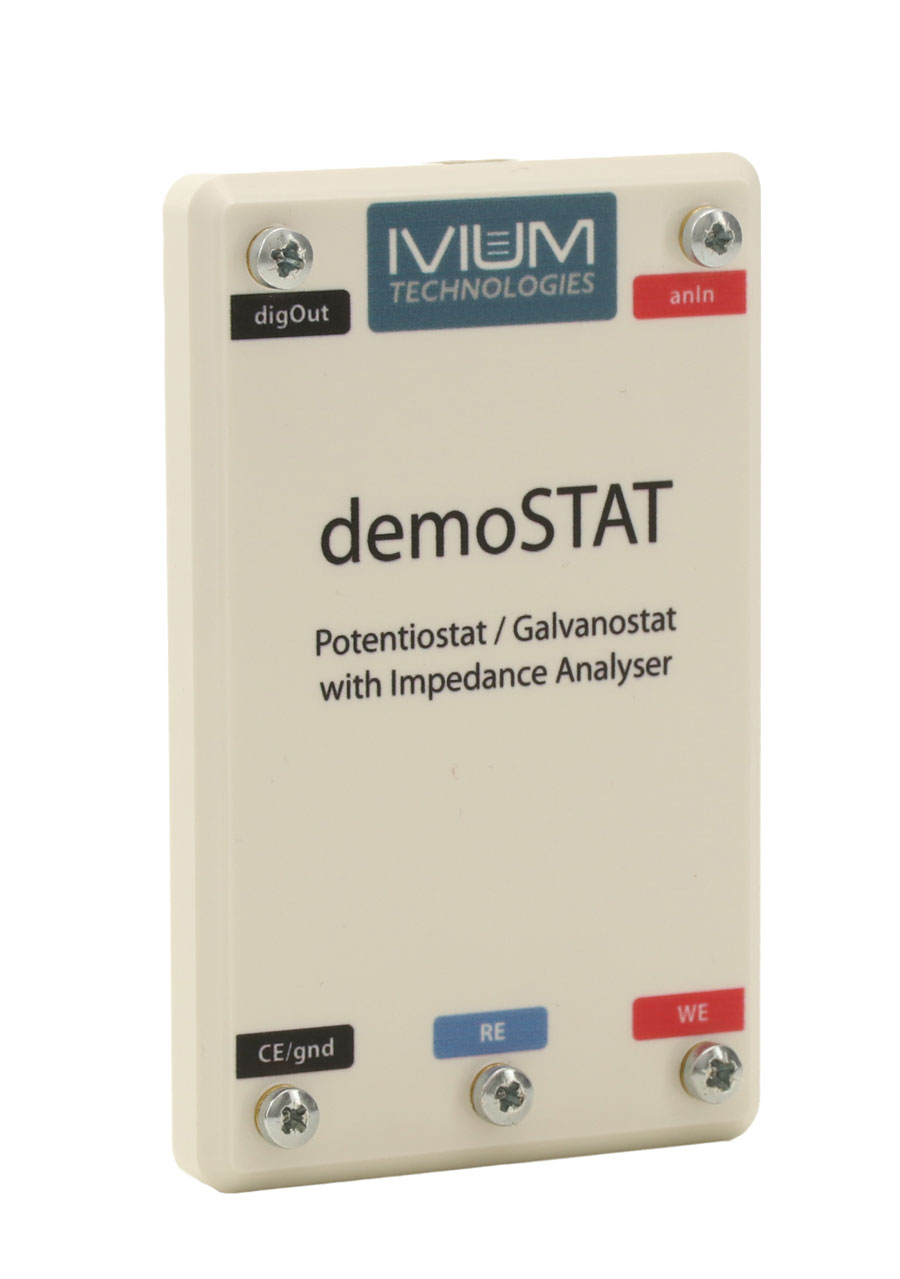
Ivium demoSTAT
Your smart introduction to electrochemical instrumentation
The demoStat is a small USB-C powered potentiostat / galvanostat / ZRA with integrated FRA/EIS. It can perform all conventional electrochemical techniques, including EIS. It is intended as a low-cost investment for feasibility studies and demonstration, but is also perfectly suited for training and education. It is controlled via a USB connection from any netbook, laptop or PC that is Windows operated.

SK-2 Electrochemistry starter kit
SK-2 is an electrochemistry starter kit with almost all accessories that you need for start your electrochemical measurement. For the start of your measurement, you only need to complete your order with a reference electrode and an electrochemical analyzer.
SK-2 Electrochemical accessories kit contains:
- SVC-3: an standard voltammetry cell with Pt CE, sample vials (7 pcs), teflon cap and gas purging tube,
- PK3: electrodes polishing kit to refresh the working electrode surface for CV/Flow cell.
- PT and GC as WEs.
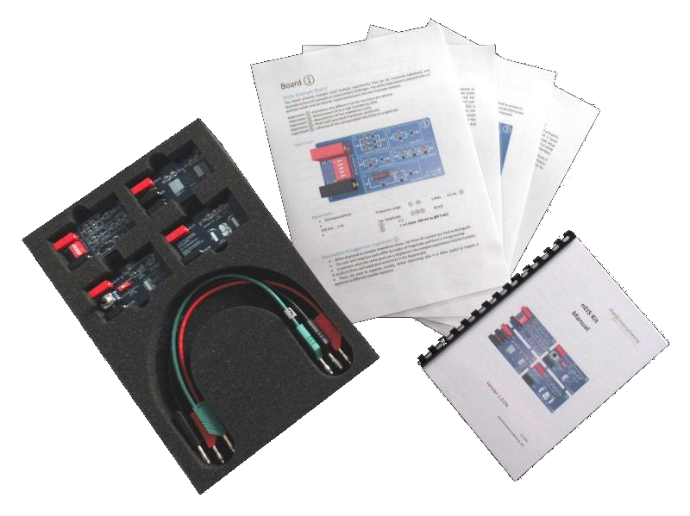
The nEIS kit.
More than a test Cell
The nEIS Kit is a collection of test circuits for impedance analyzers that simulate common measurement tasks like batteries or generic challenges like very low or very high impedance.
It is intended as both an educational tool as well as reference for tuning device parameters.
Intuitive examples for common measurement together with reference sheets, hints and examples.
Knowing the expected outcome allows you to fine-tune your EIS device settings because you can always objectively judge if a change improved the result.
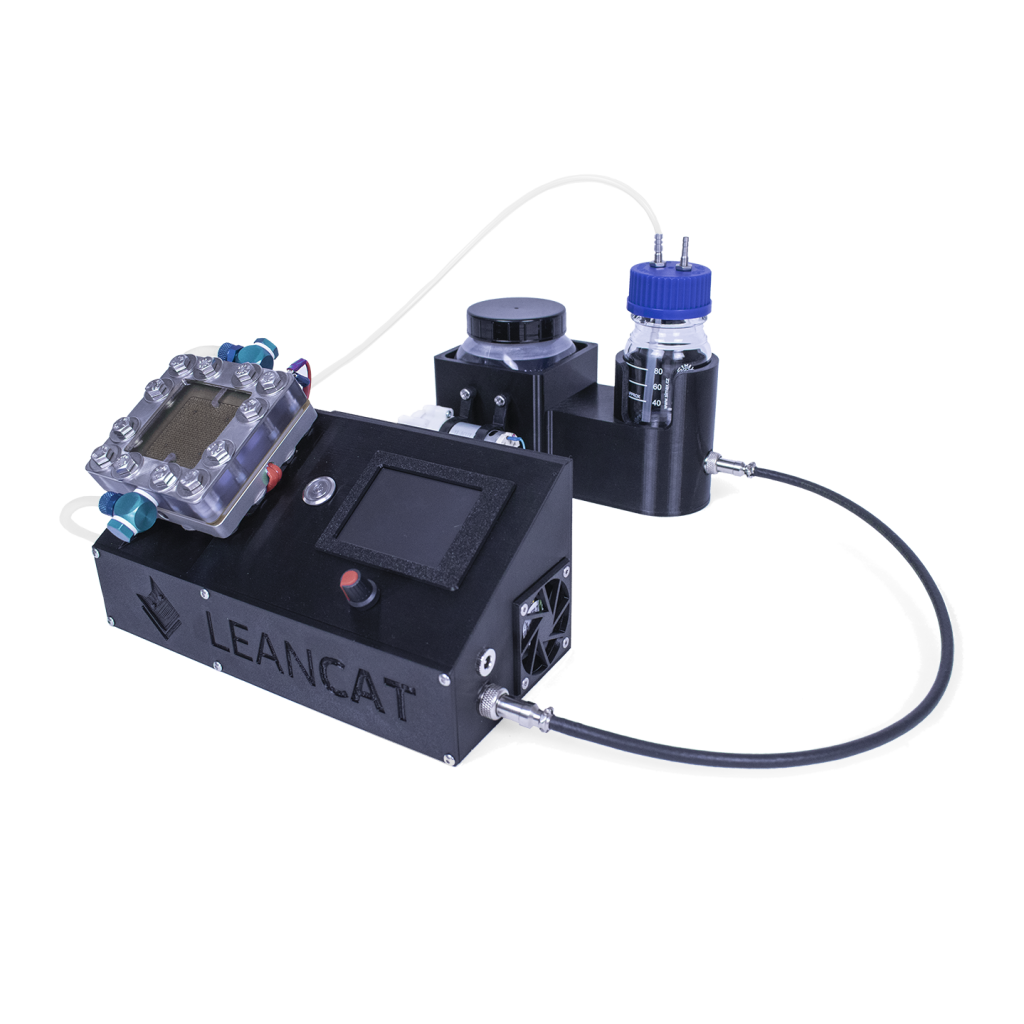
Water Electrolyzer Science Kit LCWE-kit
Generation of green hydrogen in vivo. That’s Leancat’s science kit for water electrolyzis. It uses the same industrial design and components as our full-featured electrolyzers, but it is specifically designed for education purposes. With continuous regulation of power and transparent end plate, it is possible to directly observe gas generation and characterize the behavior of the system.
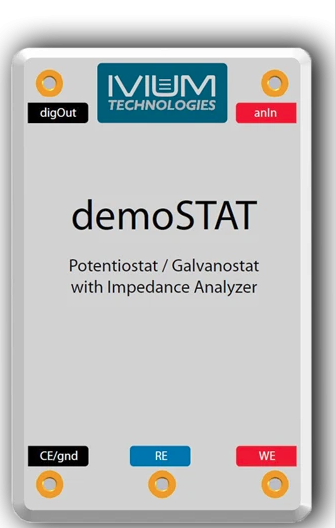
The smart introduction to electrochemical instrumentation
The demoStat is a small USB-C powered potentiostat/galvanostat/ZRA with integrated FRA/EIS. It can perform all conventional electrochemical techniques, including EIS.
It is intended as a low-cost investment for feasibility studies and demonstration, but is also perfectly suited for training and education.
It is controlled via a USB connection from any netbook, laptop or PC that is Windows operated.
Low fingerprint
Size: 95 x 60 x 8mm
Weight: 50g
Education & Training
Perfect for feasibility/demostration, training and education
EIS included
Compliance: ±5mA @ ±3V
Impedance: 10µHz to 100kHz
Performs all conventional Electrochemical techniques
including impedance up to 100kHz.
List of supported Electrochemical Techniques:
Linear Sweep Voltammetry (LSV)
Linear Sweep Current averaging (LSV CA)
Linear Sweep Potentiometry (LSP)
Cyclic Voltammetry (CV)
Cyclic Voltammetry Current averaging (CV CA)
Cyclic Potentiometry
Impedance Constant E (PEIS)
Impedance Constant I (GEIS)
Impedance Potential lscan
Impedance Current scan
ChronoAmperometry (CA)
ChronoPotentiometry (CP)
MixedMode
Eoc Monitor (EOC)
Polarization Resistance (PR)
Tafel Plot
PotentioDynamic (PD)
Cyclic Polarization
Galvanic Corrosion
Corrosion Rate Monitor
ElectroChemical Noise (EN)
CycliScan
Amperometric Detection
Differential Pulse Voltammetry (DPV)
Square Wave Voltammetry (SWV)
Normal Pulse Voltammetry (NPV)
AC Voltammetry
AC Detection
Potential Stripping Voltammetry
Voltammetric Pulse Builder
Technical Specifications
- Current compliance: ±5mA @3V (±2mA @6V)
- Maximum compliance voltage: ±3V
- Maximum applied voltage: ±3V
- Electrode connections: 3; WE, CE, RE via M3 screw terminals
- Potentiostat bandwidth: >150kHz
- Signal acquisition: Dual channel (2x16bit) ADC 100 000 samples/s
- Max. applied potential range: ±2V
- Applied potential resolution: 1 mV
- Applied potential accuracy: 0.1% of range +0.5% of value
- Current ranges: 4 ranges (±1mA, ±100µA, ±10µA, ±1µA)
- Measured potential: ±5V, 0.15mV resolution
- Measured potential accuracy: 0.1% of range +0.5% of value
- Max. current compliance: ±5mA @3V, ±2mA @6V
- Applied current resolution: 0.1% of range
- Measured potential resolution: 0.15mV resolution
- Measured potential accuracy: 0.1% of range +0.5% of value
- Frequency range: 10µHz to 100kHz
- Amplitude: Fixed 25mV potentiostatic amplitude, or 0.025*CR galvanostatic amplitude
- Error: below 1%, 1deg for 20Ohm-10kOhm Cells in 10µHz to 10kHz range
- Input impedance >100Gohm //<150pF
- Input bias current <10pA
- Bandwidth 150kHz (for 1kOhm cell at CR=1mA)
- 1 Analog input, ±5V with 0.15mV resolution
- 1 Digital output, 0/3.3V
- Power supply: USB powered, via USB-C cable
- Dimensions: 95x60x8mm, 50g
- Requirement: Windows 10 PC, with free USB C port
Lowest cost investment for electrochemical instrumentation
The demoSTAT is the direct route from teaching to professional instrumentation.
Methods & datafiles are directly compatible with the professional Ivium Instruments, for a seamless progression to research grade work: better accuracy and wider dynamic range.
The nEIS Kit
More than a Test Cell
Electrochemical Impedance Spectroscopy is a complicated technique and learning to use it effectively is a challenging task. The nEIS Kit is a collection of test circuits for impedance analyzers that simulate common measurement tasks like batteries or generic challenges like very low or very high impedance. It is intended as both an educational tool as well as reference for tuning device parameters.
In the nEIS Kit you find intuitive examples for common measurement together with reference sheets that give hints and examples. All components have specified values, allowing you to analyze your spectra to find out if the measured values match what’s on the board.
Knowing the expected outcome allows you to fine-tune your EIS device settings because you can always objectively judge if a change improved the result.

nEIS kit components
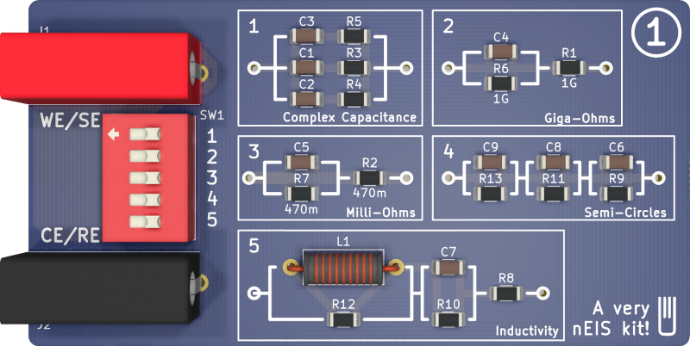
Board 1
Board 1 is comprised of 5 different experiments. These range from illustrative examples to measurement challenges. The active experiment is selected via an on-board switch.
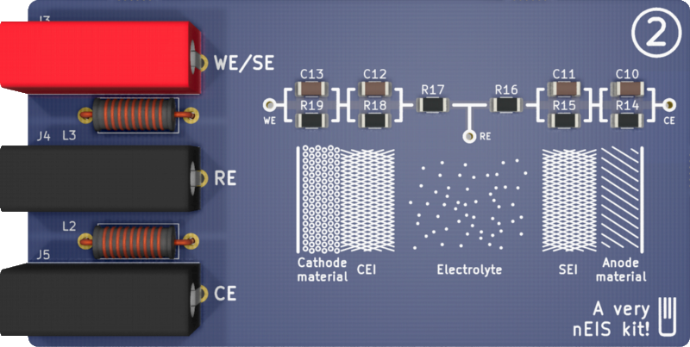
Board 2
Board 2 illustrates the usefulness of three electrode measurements in battery measurements. Find out, how a reference electrode helps in separating contributions from the two battery interfaces, and how the two- and three-electrode experiments fit together.
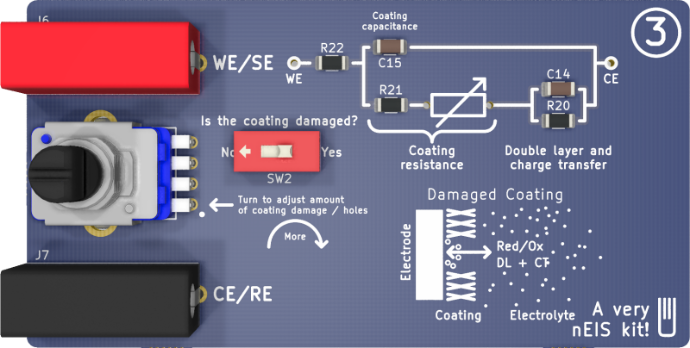
Board 3
Board 3 demonstrates typical impedance spectra of metals covered with a dielectric coating, like lacquer. The coatings may get damaged which leads to corrosion. This can be simulated on the board by enabling or disabling damage to the coating via a switch. The amount of damage can be varied by turning a potentiometer, showing the transition between minimal and maximal damage.
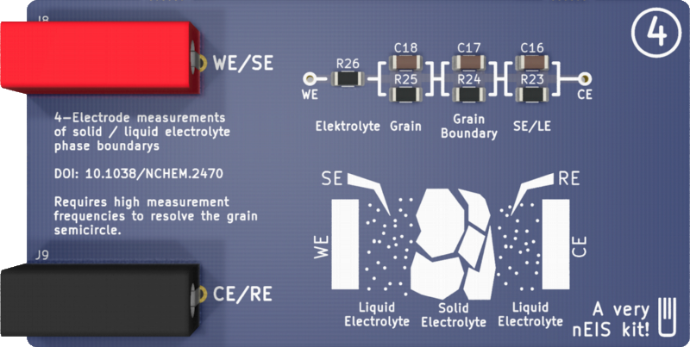
Board 4
Board 4 is derived from a four-electrode experiment on liquid/solid interfaces, that show different charge-transport paths.The nature of these processes causes contribution to the very high frequency domain of a spectrum.
The nEIS Kit is delivered, including:
- Four individual boards
- General Manual (A5)
- Individual experimental sheets (A4, laminated)
- 3x 4mm banana extension cables
The kit is delivered in a foam-lined box.
